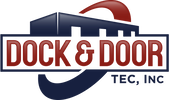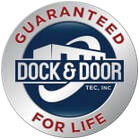|
Continued from Red Flags When Replacing a Dock Leveler: Parts 1-3…
#4 — The ripple effects. Gain a full understanding of your downtime. This will be magnified if you’re doing any additional repairs or work on the loading dock area. Many companies utilize various subcontractors which are very specialized and only work on individual pieces of loading dock equipment. This could potentially drag out your downtime creating other issues for you. #5 — Dock bumpers and the mounting surface. This is actually the most critical part of the dock as it protects the dock leveler and the building. The bumpers also properly position the truck to allow it to be secured by truck restraints (dock locks), assuming you’re utilizing them. Older buildings may have cracked or damaged concrete possibly due to improperly installed bumpers. Be sure this is looked at. It is more cost-effective to repair during the leveler replacement process. Be careful changing bumper projection or size, this can affect the effectiveness of dock seals or truck restraints (dock locks). #6 — If upgrading to an air or hydraulic leveler that will require electrical work be sure you have a full understanding of the cost. Plus how the electrical panel and wiring will physically fit. This will help avoid surprises and hidden costs once the installation begins. These six red flags are a few of the things that need to be identified prior to starting a project to replace a dock leveler. If you need additional information or are contemplating the best approach feel free to contact us at any time. Jay Anderson President/Owner – Dock & Door Tec. Often we visit potential clients who are interested in replacing dock levelers. The potential client has already met with other suppliers who may or may not have provided information and a proposal. Today we speak to one client, in particular, the client was now looking for additional quotes. Unfortunately, the information they received was not correct, which makes the pricing irrelevant. We hope to provide you information of value based on this particular meeting identifying key items to be aware of when planning to replace a dock leveler.
Over the past 22 years that I’ve been in the loading dock and door industry I have worked as an installer/technician, account rep, operations manager and for the past 8 years a business owner. Not surprisingly these are some of the things I have come across repeatedly. When considering a replacement leveler be sure you have a full understanding of these red flags. #1 — Rear Curb Angle. This critical piece of steel should be embedded into the concrete when the dock pit was initially constructed. There is no maybe with this. It is pass or fail. If the person you’re meeting with to the review pricing and installation cannot tell you a definite yes or no in regards to a replacement, find a new company to partner with. Untrained and/or careless installers have been known to break rear curb angles loose when removing the old leveler, lookout for a “maybe” story on the front side. A high-quality company with high-quality installations will be able to tell if the rear curb angle is a pass or a fail. Other curb angles (side, front or vertical) may need repair or replacement as well. An educated and properly trained rep will be able to tell by looking, even with the old leveler still in the pit. #2 — Forklift capacity, weight, and usage. Not all dock levelers are created equal, neither are the manufacturers that build them. One manufacturer may recommend a 30,000-pound capacity leveler and another may recommend a 45,000-pound capacity leveler. Be sure to get the manufacturer usage and weight charts or data before making a decision. If the company you’re working with cannot clearly explain how this works and supply clear cut manufacturer-provided information find a new company to partner with. #3 — Is everything else OK? What issues are you having with the existing equipment? What works? What doesn’t? These questions need to be reviewed. Changing something as simple as the dock bumpers can create issues. Read on! … View Parts 4-6 in next week’s post These first three of six red flags are a few of the things that need to be identified prior to starting a project to replace a dock leveler. If you need additional information or are contemplating the best approach feel free to contact us at any time. Thank you for reading! Jay Anderson President/Owner – Dock & Door Tec. An ounce of prevention is worth a pound of cure…..we probably all heard our parents mutter those words to us as we were young and easily influenced, at this point, we didn’t really give it a second thought. That saying certainly holds true when it comes to your overhead doors. They’re one of those items that many people never really give a second thought to, until they become inoperable and you have a dock position out of service. These things seem to have a way of happening at the most inopportune moment possible and can turn something that could have been a very simple fix into a major inconvenience costing both time and money.
A simple maintenance program that could work in conjunction with your other loading dock equipment (dock leveler, vehicle restraints, door operator, fire doors, high speed doors, etc etc) can help you stay out in front of surprise emergencies….we could all use less of those. If you have any of the following conditions it might be money well spent to get your doors looked at by a professional technician and help reduce your exposure to potential breakdowns and safety issues.
If you would like to have us take a look at your overhead doors or any of your other loading dock equipment and have a conversation about their condition and how we can help reduce maintenance costs give us a call here at Dock & Door Tec. Brett Korinek Account Manager – Dock and Door Tec Since before the first loading dock was installed dock safety has been a concern. As the equipment got better, faster and heavier so too has the danger of working on a loading dock. We have all heard that safety is everyone’s responsibility but after seeing what I have seen on the docks, I question that old adage. I have seen fully loaded forklifts going far faster than they should, I have seen dock equipment ready to collapse being used. I have even seen my boss nearly crushed by a forklift.
So, who is really responsible to stop these mishaps and near misses? In the end, it is your reasonability to keep yourself safe first. You may say that it’s a self-centered act to think of yourself first but I contend that if everyone considered their personal safety first then everyone as a collective unit would be safer as a whole. It may be difficult to eliminate all loading dock mishaps but it is possible to minimize the damage to both personnel and equipment.
This is a very limited list and each facility has its own unique challenges, know your surroundings and keep yourself safe. Rick Hopkins Operations Manager, Dock & Door Tec When planning and configuring a loading dock area in your facility, cost certainly comes into consideration. All too often up-front cost dictates what equipment is installed and who the installers will be. During the bidding process, the end-use application fades into the background and jostling for “who can come in at the lowest price” takes precedence.
Some important things to pay attention to during the bidding process. As you are collecting bids, keep in mind your specific or unique needs. Be sure you are working with a company or installer that is going to pay attention to your details. They may not be the least expensive but in the long term, will they stand behind their workmanship and take care of your needs? There are many instances where incorrect equipment and substandard installation have cost businesses hundreds of thousands of dollars in repairs. Repairs that, had the proper equipment been installed correctly, would have never hit those companies’ pocketbooks. Not to mention the possible safety issues that could arise putting their businesses at risk. Under-rated levelers, edge of docks installed with incorrect service ranges, 10,000 cycle torsion springs installed on doors being cycled 150 to 200 times a day, mounting bolts rubbing on door cables. Do the upfront dollars still look that great? Is saving a little money upfront worth the downtime and repair bills that are in store for you? One simple way to recognize if these issues are affecting your company’s pocketbook: How many times have you had to pay for the same repair over a 2 to 3-year timeframe? If it’s more than 3 times, you may have an equipment or installation issue on your hands. Three steps to keep your facility running smoothly and in the black:
Your company and employees will thank you. |
AuthorVarious. Categories
All
Archives
August 2023
|
- Home
- About
- Career Opportunities
- Services
-
Equipment
- Dock Locks (Truck Restraints) >
- Fans & In-Plant Equipment >
-
Industrial / Commercial Doors
>
- High Speed Fabric Doors
- Security High Speed
- Rubber Doors
- Fire Door
- Rolling Steel
- Impactable Dock Doors
- Cooler / Freezer
- Fabric Roll-Up
- Impact / Traffic / Bump
- Overhead / Sectional Doors
- Operators / Activation
- Air Curtains / Screen & Bug Doors
- Strip Doors
- Door Entrapment Protection
- Door Protection
- Overhead Door Upgrades
- Loading Dock Levelers & Lifts >
- Loading Dock Seals & Shelters >
- OEM & Aftermarket Parts
- Safety / Energy / Security / Employee Comfort >
- Yeti Snow Removal
- Markets
- Blog
- Contact
Dock & Door Tec
Serving Minnesota, Wisconsin, Iowa, North Dakota & South Dakota
Serving Minnesota, Wisconsin, Iowa, North Dakota & South Dakota

 RSS Feed
RSS Feed
